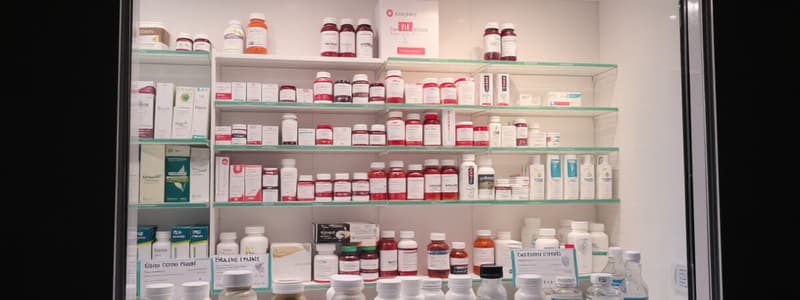Podcast
Questions and Answers
Which diffusion method is primarily associated with the movement of water-soluble substances?
Which diffusion method is primarily associated with the movement of water-soluble substances?
- Carrier-mediated transport
- Lipid diffusion
- Facilitated diffusion
- Aqueous diffusion (correct)
What is implied by the phrase 'time close to 0' in relation to the provided content?
What is implied by the phrase 'time close to 0' in relation to the provided content?
- Slow elimination rates
- High dosage frequency
- Increased toxicity levels
- Fast absorption rates (correct)
Which type of diffusion is likely to occur for lipid-soluble substances?
Which type of diffusion is likely to occur for lipid-soluble substances?
- Lipid diffusion (correct)
- Aqueous diffusion
- Active transport
- Carrier-mediated transport
Which of the following processes describes the mechanism underlying carrier-mediated transport?
Which of the following processes describes the mechanism underlying carrier-mediated transport?
What is the main difference between an agonist and a pharmacologic antagonist?
What is the main difference between an agonist and a pharmacologic antagonist?
Which of the following best describes pharmacogenomics?
Which of the following best describes pharmacogenomics?
What distinguishes a generic drug from a proprietary drug?
What distinguishes a generic drug from a proprietary drug?
Which phase of drug development involves testing the drug on a large scale for efficacy and side effects?
Which phase of drug development involves testing the drug on a large scale for efficacy and side effects?
What does the Henderson-Hasselbalch equation primarily help to determine?
What does the Henderson-Hasselbalch equation primarily help to determine?
Which routes of drug administration are often compared in pharmacology?
Which routes of drug administration are often compared in pharmacology?
During which time period did significant advancements in chemistry and physiology occur that laid the foundation for pharmacology?
During which time period did significant advancements in chemistry and physiology occur that laid the foundation for pharmacology?
What did the term 'materia medica' originally refer to?
What did the term 'materia medica' originally refer to?
What effect does low pH have on the form of a weak acid drug?
What effect does low pH have on the form of a weak acid drug?
Which of the following accurately describes permeation in drug absorption?
Which of the following accurately describes permeation in drug absorption?
What primarily drives the passive diffusion of drugs across membranes?
What primarily drives the passive diffusion of drugs across membranes?
Which option best represents the absorption mechanism through which drugs move into systemic circulation?
Which option best represents the absorption mechanism through which drugs move into systemic circulation?
How does the route of administration affect drug permeation?
How does the route of administration affect drug permeation?
Which factor does NOT influence the proportion of a drug that is permeable through a membrane?
Which factor does NOT influence the proportion of a drug that is permeable through a membrane?
What main process allows the movement of drug molecules from a higher concentration to a lower concentration across a membrane?
What main process allows the movement of drug molecules from a higher concentration to a lower concentration across a membrane?
In pharmacokinetics, which statement regarding weak acid and weak base drugs is accurate?
In pharmacokinetics, which statement regarding weak acid and weak base drugs is accurate?
What is meant by the term 'MEC' in pharmacology?
What is meant by the term 'MEC' in pharmacology?
How does the plasma concentration of a drug typically behave over time?
How does the plasma concentration of a drug typically behave over time?
What does a 'wide therapeutic window' imply about a drug?
What does a 'wide therapeutic window' imply about a drug?
Why might a patient not feel the effects of a drug immediately after administration?
Why might a patient not feel the effects of a drug immediately after administration?
If a patient's plasma concentration of a drug decreases below MEC, what is likely to happen?
If a patient's plasma concentration of a drug decreases below MEC, what is likely to happen?
What is essential for creating a safe drug regimen?
What is essential for creating a safe drug regimen?
Which factor most directly affects when a patient will feel the drug's effects?
Which factor most directly affects when a patient will feel the drug's effects?
What can cause a drug concentration to approach the MEC again after it has decreased?
What can cause a drug concentration to approach the MEC again after it has decreased?
What does a 'narrow therapeutic window' imply?
What does a 'narrow therapeutic window' imply?
What occurs at the Cmax of a drug concentration?
What occurs at the Cmax of a drug concentration?
How does the Minimum Effective Concentration (MEC) influence drug dosing?
How does the Minimum Effective Concentration (MEC) influence drug dosing?
What is represented by the 'bell-shaped graph' in therapeutic windows?
What is represented by the 'bell-shaped graph' in therapeutic windows?
What is a critical consideration when administering a drug with a narrow therapeutic window?
What is a critical consideration when administering a drug with a narrow therapeutic window?
What happens to the properties of the drug when the MEC is too high?
What happens to the properties of the drug when the MEC is too high?
What is typically the consequence of reaching the toxic response point in drug concentration?
What is typically the consequence of reaching the toxic response point in drug concentration?
Which factor is critical in determining the proper drug dose within a narrow therapeutic window?
Which factor is critical in determining the proper drug dose within a narrow therapeutic window?
What effect does drug administration timing have on achieving MEC?
What effect does drug administration timing have on achieving MEC?
What is one major consequence of failing to maintain drug levels within the therapeutic window?
What is one major consequence of failing to maintain drug levels within the therapeutic window?
Flashcards are hidden until you start studying
Study Notes
Pharmacology Overview
- Pharmacology studies the interactions between drugs and biological systems.
- Important principles include pharmacodynamics (effects of drugs on the body) and pharmacokinetics (how the body affects drugs).
Key Concepts
-
Agonists vs. Pharmacologic Antagonists:
- Agonists activate receptors to produce a biological response.
- Antagonists block receptor activation, preventing a biological response.
-
Pharmacodynamics and Pharmacokinetics:
- Henderson–Hasselbalch equation explains drug ionization based on pH.
- Drug action involves absorption, distribution, metabolism, and excretion.
-
Routes of Drug Administration:
- Various methods include oral, intravenous, and topical, each with distinct absorption characteristics.
-
Pharmacogenomics:
- Studies how genes influence individual responses to drugs, allowing for tailored medication therapies.
-
Generic vs. Proprietary Drugs:
- Generic drugs have the same active ingredients as proprietary (brand-name) drugs but may differ in inactive ingredients and appearance.
Drug Development Phases
- Development includes pre-clinical research, clinical trials (Phases I-III), and post-marketing studies to ensure safety and efficacy.
Historical Context
- Prehistory:
- Early remedies derived from plants and animals, often harmful or ineffective.
- 17th Century:
- Shift towards observation and experimentation in medicine; emergence of materia medica as a precursor to pharmacology.
- 20th Century Advancements:
- Rapid expansion in biological research and innovation shaped modern pharmacological understanding.
Drug Absorption Mechanisms
- Permeation:
- Movement of drug molecules across membranes is critical for absorption; occurs through passive diffusion, carriers, or active transport.
- Concentration Gradient:
- Drugs move from areas of high concentration to low concentration, affecting absorption rates.
Therapeutic Window
- Refers to the range between effective drug concentration (minimum effective concentration, MEC) and toxicity levels.
- Maintaining the correct dosage is crucial to stay within this narrow therapeutic window for safety and efficacy.
Key Terms
- Aqueous and Lipid Diffusion:
- Two primary mechanisms of drug permeation depending on solubility.
- MEC and Cmax:
- Minimum effective concentration is the lowest drug concentration for desired effect; Cmax indicates peak concentration that can lead to toxicity if exceeded.
Studying That Suits You
Use AI to generate personalized quizzes and flashcards to suit your learning preferences.




